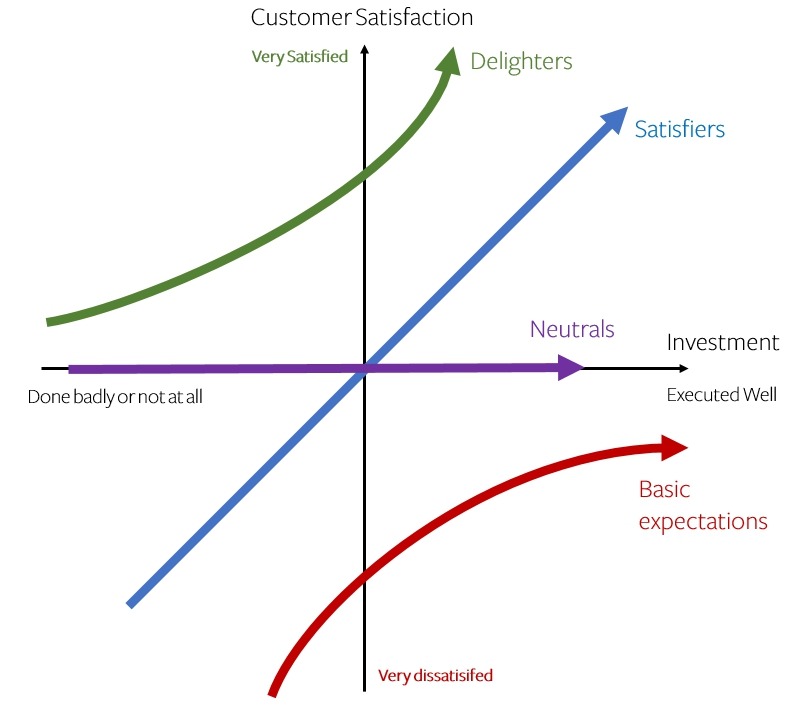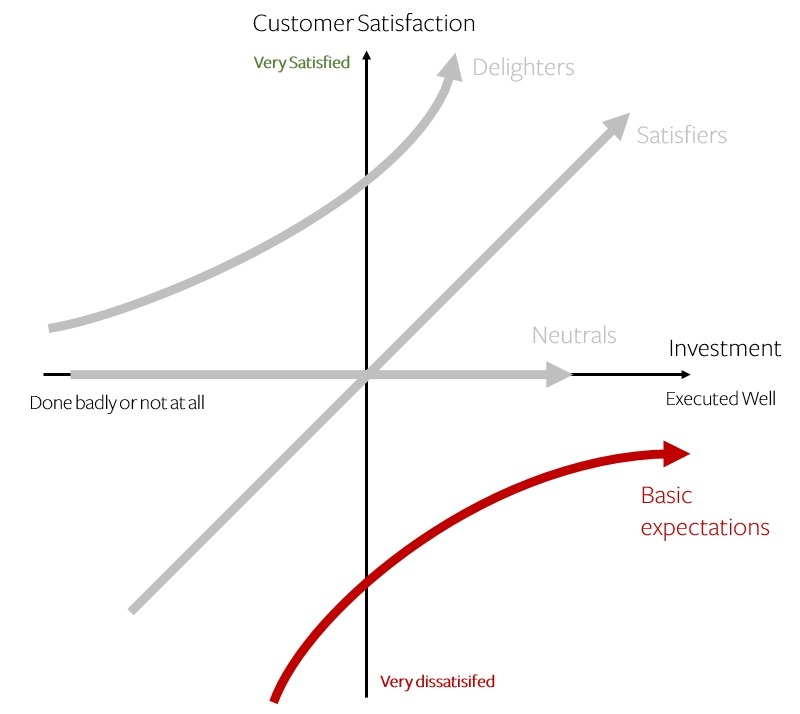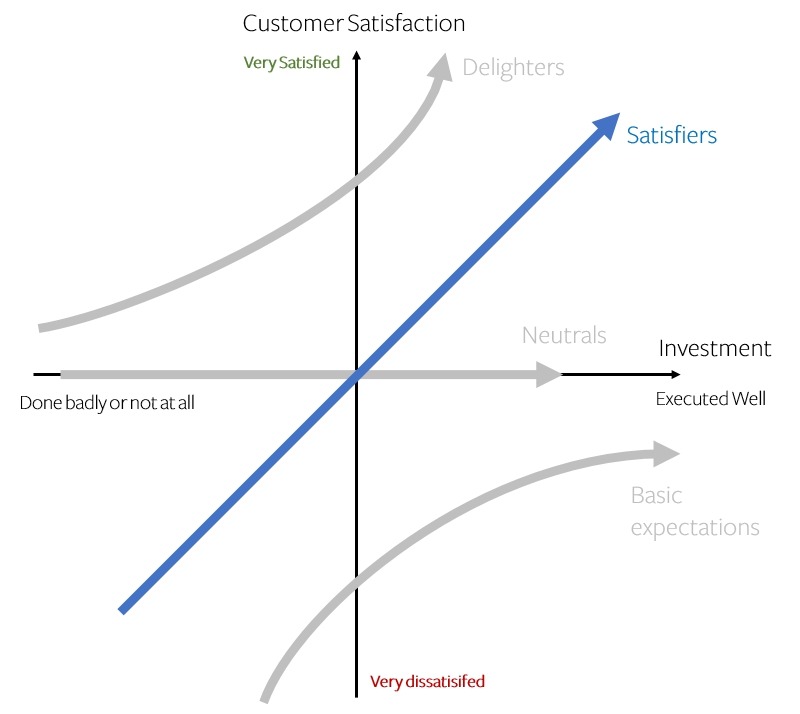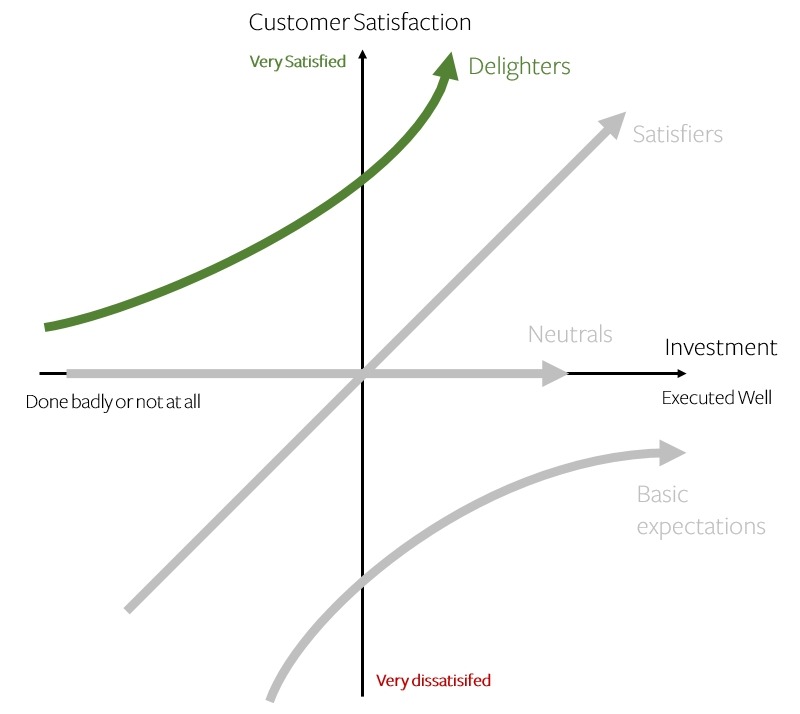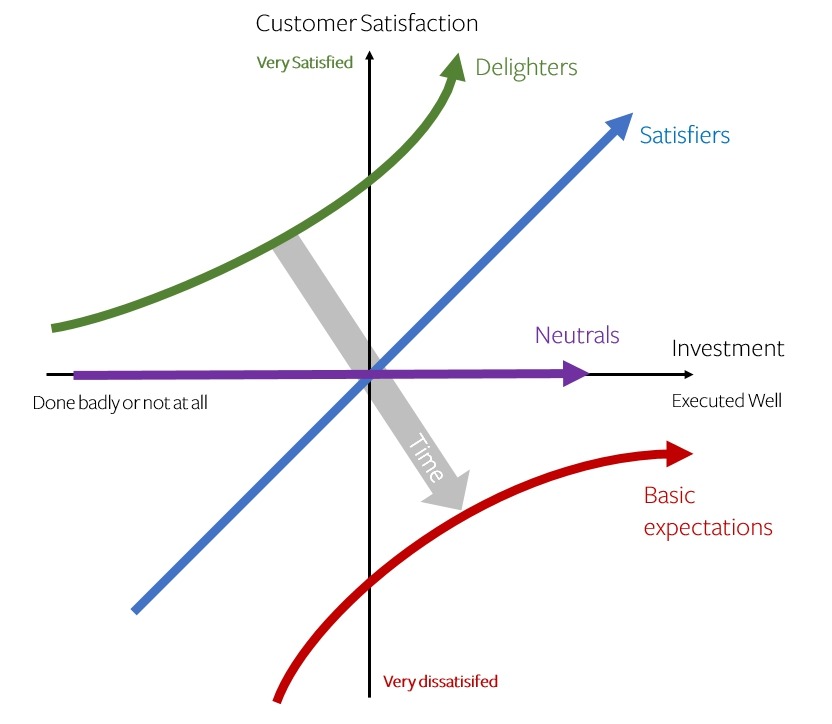The Kano model is a framework developed in the 1980s by Professor Noriaki Kano of Tokyo University, which helps to inform customer satisfaction and feature development within a digital product (or any product in fact).
It can drive meaningful conversations around product strategy, development priorities and define areas of success when you go to market.
How does the Kano model work?
In the simplest terms, the Kano model maps user expectations against effort (read: investment) to develop.
You can broadly categorise features into four separate areas or types:
Basic Expectations: These are key features that a product must have in order to be able to compete at all.
Neutral: “Features” that do not add any tangible customer benefit.
Satisfiers: Add more of these or develop them further and customer satisfaction will increase proportionally.
Delighters: Your opportunity to set your product apart from the rest – use these to create your unique value proposition that will please your customers and sales teams in almost equal measure!
With these four categories in place, you can then plot them on a graph:
On the ‘x’ axis lie sophistication of features, alongside effort and investment to develop, with customer satisfaction on the ‘y’ axis.
To illustrate the correlations and simplify things slightly, let’s take each category in turn.
Basic Expectations
If you don’t include these features, frankly you won’t stand a chance! Oft-cited examples are that of a hotel without a bathroom, or a car without a steering wheel.
In digital terms, you could think of a subscription product without functioning login or authentication frameworks in place.
You’ll notice that these features are so basic, so fundamental, that their inclusion still doesn’t push satisfaction above the base-line.
Points of note:
– Understand your market and the competitive landscape so you can be sure of including critical functionality.
– Ignoring these features will inevitably mean the loss of customers to direct competitors and will be damaging to your brand, potentially having knock-on effects in other areas of your portfolio.
Neutrals
The ‘neutral satisfiers’ often end up being the biggest area of budget and investment dissipation, not least because they can be tricky to identify.
These are features that do not add any satisfaction to your end user, so regardless of the investment put in, you will see no tangible return.
In the digital arena, development teams may add features simply ‘because they can’, and designers are guilty too! The addition of these unwanted features is bloat within the product, which can have other detrimental effects including extra maintenance and increased cost of ownership.
Review your product backlog and identify the offenders… There can be overlap between neutral satisfiers and ‘active satisfiers’ – this is often the product of customer segmentation, where different users want and are delighted by different things. If you can truly validate demand, then get around this by using different pricing and subscription modelling to separate these users and drive return on investment.
Points of note:
– Keep the complexity of features in check and validate with customers before investing in development.
– Use the results to inform and develop your pricing strategies and commercial model.
Satisfiers
Satisfier (or “performance”) features should form the backbone of your product’s development – the more you add and invest here, the more satisfaction you generate. It sounds trivial, but a word of caution: if these features are implemented poorly, you risk actively generating user dissatisfaction.
To stick with the vehicle example, an obvious satisfier could be greater MPG; the higher the figure, the greater the level of customer satisfaction.
If you were offering cloud storage (e.g. Dropbox) then a larger number of free GB would be similarly linear in satisfaction gains.
In a data product, satisfiers may include workflow tools for analysis or reporting which have tangible time or money saving benefits.
Points of Note:
– As with the neutral features, it is important you validate what your user-base will value before defining investment into the feature-set.
– Once you’ve defined your product backlog, whatever you choose to implement, execute it well to avoid achieving the opposite of your good intentions…
Delighters
This is your time to shine. Delighters will set you apart and add real value to your product – by definition these features should come as a pleasant surprise to your customers, but also have meaning and be useful.
A small investment in this area can result in high levels of customer satisfaction. Delighters can be harder to unearth and often require some level of speculative investment to deliver. The return on your investment can be great, as delighters leave a memorable distinction from your competition.
As valuable as they are, delighters have a shelf life. As time goes by, they shift across the graph area, until they have inexorably become basic expectations!
A good example is the option of free delivery when purchasing online – the concept of no-cost fulfilment was genuinely newsworthy, and only a few years later, suppliers on Amazon that charge to deliver can expect dramatically lower order rates than their competitors.
Delighter decay over time
Points of Note:
– Use customer surveys and feedback to try and uncover possible delighters, while keeping an eye out for the erosion of existing ones.
Conclusion
The Kano Model is a very helpful method of keeping your product backlog in check, and concentrating on features that will provide value for your customers and justify your investment, two of the most important metrics out there!
The common theme is one that any successful product owner will advocate – talk to your customers, talk to them often, and listen.

